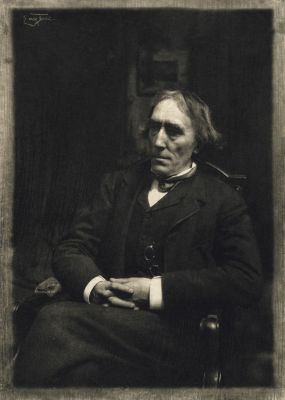
Title
MinuetArtist
Eugene, Frank (American, 1865-1936)Publication
Camera Work XXXDate
1910Process
PhotogravureAtelier
F. Bruckmann Verlag, MunichImage Size
12.5 x 17.5 cm
Eugene’s concentration on "portraits of gentlemen" mirrors not only the personality cult of the time but also the traditional roles of the sexes in the period up to 1914. The male sitters are represented, often in half-length photographs, as striking heads with marked individual features and psychological depth, whereas the women are depicted mainly as the embodiment of a decorative ideal of beauty. This intention is supported by the addition of a few accessories such as shells, strings of pearls and sprays of flowers, and by Eugene’s particular attention to the reproduction of the texture of their clothing. Occasionally the women are also presented as the personification of music, mostly as violin or lute players in the pose of sensitive introverted, dreamy figures whose spiritual expression mirrors the refined awareness of life of the "lady" from high social circles. To quote Fritz von Ostini, this kind of figure represented the most delicate, differentiated and attractive form of the female that our time has moulded; spiritual through education, physically ennobled through selective breeding and culture, elevated through tasteful clothing and surroundings. Thus Eugene’s pictorial world was not essentially different from that of a painter such as Friedrich August von Kaulbach, the much acclaimed portraitist of the nobility and the haute bourgeoisie whose portraits record a conservative and highly patriarchal society in which women assumed the role of the sensitive soulful muse. [1]
Reproduced / Exhibited
Nordström, Alison D, Thomas Padon, and J L. Ackerman. Truthbeauty: Pictorialism and the Photograph As Art, 1845-1945. Vancouver, B.C: Douglas & McIntyre, 2008. p 31
References
[1] Eugene, Frank, and Ulrich Pohlmann. Frank Eugene, the Dream of Beauty. Munich: Nazraeli Press, 1995. p. 85









